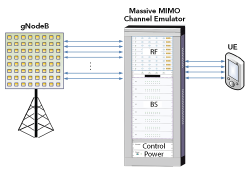Several popular channel models, such as WINNER,12 COST 210012-13 and METIS 2020,13 have attracted more attention due to their scalability and reasonable complexity. These 5G channel models are adapted to specific scenarios and frequency bands. Although the mathematical methods used are not the same, these models are based on the analysis of a large number of channel sounding results. At the 3GPP RAN meeting held from June 13 to 16, 2016 in Bushan, Korea, the first standard for the mobile broadband 5G high frequency (6 to 100 GHz) channel model was approved. So far, there has been no unified 5G channel model integrating both low and high frequency bands, which requires the corresponding aspects of 5G wireless technology to be taken into account. Extensive work on theoretical and practical channel modeling has been done during the past few years, but most research results are constrained by spatial correlation and mutual coupling between adjacent antennas. Arrangement of antenna elements is relatively simple and assumptions about propagation conditions and antenna characteristics are too idealistic and limited to specific application scenarios. Therefore, it is difficult to accurately extract a variety of actual channel characteristics.

Figure 2 5G channel emulator.
Channel Emulation
When conducting field tests for wireless communications systems in the real channel environment, there are many shortcomings, such as climate effects, poor mobility, high cost and unrepeatable test processes. The MIMO channel emulator (see Figure 2) enables researchers to emulate typical wireless channel environments in the lab, flexibly controlling and changing channel parameters, to identify performance problems as early as possible, reduce test costs and significantly improve efficiency.14 Therefore, manufacturers have always included channel emulation as a critical part of the deployment of each generation of mobile communications technology, including 5G.
As a key technology for 5G, massive MIMO greatly reduces transmission power while improving channel capacity and spectral efficiency.15 Nevertheless, the required number of network equipment antennas is 10 to more than 100x that of existing MIMO system antennas, which becomes a major bottleneck in the upgrade and optimization of current 4G/LTE channel emulators. The inherent “pilot contamination” problem of massive MIMO technology directly affects the baseband channel estimation algorithm, feedback mechanism, interference control and synchronization scheme.16-18 Data throughput in the channel emulator increases sharply with expanding antenna array size, requiring extremely high-level computational resources, storage capacity and bus speed for the baseband processing unit. The RF system design must ensure isolation and amplitude/phase consistency among multiple channels, which greatly increases channel calibration complexity.
Currently, Propsim F32, an advanced channel emulator from Anite (acquired by Keysight in 2015), is only able to support 32 RF channels at most and realize 64 × 8 MIMO channel emulations by combing multiple instruments. Unfortunately, this only covers operating frequencies below 6 GHz and a maximum bandwidth 80 MHz; it is unable to cope with the high frequency and large bandwidth challenges of 5G test. Another channel emulator, Vertex, released by Spirent in 2016, is configured with 32 RF channels and 100 MHz bandwidth to meet the requirements of MIMO beamforming, MIMO over-the-air (OTA) and massive MIMO test, but the maximum operating frequency to 5.925 GHz merely satisfies low frequency 5G test demands.
Over the years, a handful of Chinese instrument manufacturers have launched 8 × 8 MIMO channel emulators for 4G testing, laying a hardware platform and algorithm architecture foundation for the development of 5G channel emulators. Future channel emulator technology must achieve bandwidths of hundreds of MHz, cover frequency bands beyond 6 GHz and contain multiple channel models.
RF Module and Antenna Array Test
Large-scale antenna arrays and RF front-ends are essential 5G subsystems, consisting of digital-to-analog converters (DAC), analog-to-digital converters (ADC), frequency synthesizers and transmit/receive (T/R) multi-beam antenna arrays. The T/R array contains RF components such as filters, mixers, power amplifiers and low noise amplifiers, each with its own set of performance specifications and corresponding test methods.
